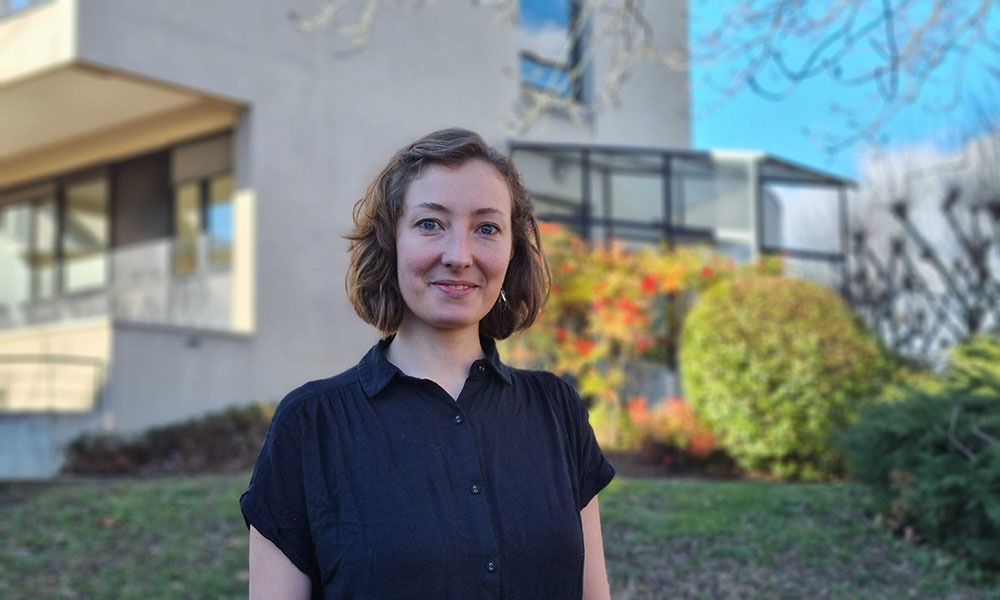
We are EMBL: Melanie Schneider on changing career trajectory
ARISE fellow Melanie Schneider shares how she uncovered a new interest in research infrastructures and supporting discovery

Working in a research infrastructure requires a different set of skills from other careers in academia. This includes the provision of scientific services and user support, managing budgets, and leading large and diverse teams. EMBL’s ARISE programme trains fellows for a wide range of careers in research infrastructure, from developing novel methods to operational and strategic management.
After completing a two-year project on drug target tractability at EMBL-EBI and Open Targets, Melanie Schneider took a leap of faith to explore a longstanding interest in research infrastructure with the help of an ARISE fellowship.
What is your background?
I have a multidisciplinary background. I did my undergraduate degree in integrated life sciences, meaning biology, biomathematics and biophysics, and my Masters degree in molecular bioengineering. I did a PhD in France on a project dedicated to (protein) structure-based drug design. This was about 80% computational involving molecular modelling, simulations, docking and machine learning, but also included some wet lab work.
After my PhD, I came across a job advert for a Protein Computational Scientist working on drug targets at EMBL-EBI, and I thought “ok, this is my dream job”, so I applied. In a nutshell, drug targets are the biomolecules (typically proteins) that are associated with a disease. Figuring out what chemicals can bind to specific targets (for example, by binding a small molecule drug) is important for understanding how to treat disease.
How did you find out about the ARISE programme?
As my project at EMBL-EBI and Open Targets was coming to an end, I spoke to my team leader, Andrew Leach, about the next step in my career. He told me about a few different opportunities, and mentioned the ARISE programme, which is a career accelerator for scientists working in research infrastructures, like EMBL-EBI. This really caught my attention.
What attracted you to the ARISE programme?
I worked in a computational (bioinformatics) research facility as a student, which I enjoyed a lot, and I have always been interested in finding out more about how they work. I liked the idea of helping other scientists plan and advance their research. It’s a great way to develop your problem-solving and creative skills, and it means you get a lot of variety in your day-to-day job.
To my knowledge, ARISE is the only programme dedicated to those who want to work and manage research infrastructures. So given my interest in research facilities, I thought it was an obvious choice.
How are you finding ARISE so far?
ARISE gives you a great overview of how research infrastructures are set up, how to approach managing them, what to consider, understanding users’ needs, and balancing budgets. These are skills you don’t usually get working as a researcher.
It’s not always easy to get this kind of information unless you get a chance to work in a research infrastructure, so ARISE is a great place to start because it equips you with the right mindset and useful skills.
The programme organisers are doing a great job and are very open to feedback and considerate of the fellows’ needs. For example, when I went on maternity leave (twice!), they were very supportive, and helped me organise things so I didn’t feel like I was missing out. There is a big emphasis on flexibility and the individual circumstances and interests of the fellows, which is reflected across different aspects of the programme, from the secondments to the on-demand learning elements.
What is your ARISE project about?
My project focuses on the flexibility of proteins, which are the working engines in all living things. I’m trying to understand how proteins change shape and accommodate different drugs. Using data from the Protein Data Bank in Europe (PDBe) and high-throughput crystallography results, I am exploring how to analyse protein structure ensembles in an automated way. I’m particularly looking at how flexible proteins are at room temperature, as opposed to the cryogenic conditions often used to experimentally determine the structures.
My project itself is purely computational and dedicated to streamlined data analysis, but with the ultimate aim to facilitate the work of experimental scientists. Therefore, direct interaction with experimental projects is very important to be able to address the scientists’ questions and needs.
What useful skills or experience have you gained so far?
I’ve gained a lot of experience in different areas of software development, in particular developing user interfaces. This is a completely new area for me, and a very different approach from my research days because it focuses on how to make analysis tools more accessible to people who don’t necessarily have any computational skills and may even be non-experts of the field.
EMBL is also a great place to develop contacts. As part of EMBL-EBI’s Industry Programme, we are in regular contact with private sector companies, and we get useful insights into their needs and how academia and industry can work together.
I am very grateful for the support and advice of my supervisor Andrew Leach (Chemical Biology Services), my advisors José Marquez (EMBL Grenoble) and Sameer Velankar (PDBe), and my mentor Janet Thornton.
What are your plans after ARISE?
I would love to get a position in a research facility, in industry or academia, helping others to develop their research projects. I enjoy sharing scientists’ excitement as their research starts to yield results. It is a pleasure to help researchers to advance a step further than what they would be able to do on their own.
As EMBL celebrates its 50th anniversary in 2024, what do you think will be EMBL scientists’ next big milestone?
In the field of structural biology there was a very significant recent development with the introduction by DeepMind of its AlphaFold2 program, which can predict structures of proteins from their sequence. The wealth of predicted structures, which is provided to the community jointly by DeepMind and EMBL-EBI through the AlphaFold Protein Structure Database, already accelerates and enables many new discoveries.
Still, there is a limitation that many current tools aim to predict single structures, rather than ensembles or structural distributions, which would better reflect protein motion and therefore tell us much more about processes and function. Accurate prediction of protein dynamics is from my perspective the next big milestone in the field of structural biology that will impact many connected areas, such as pharmaceutical biology.


